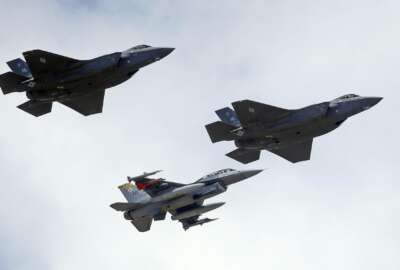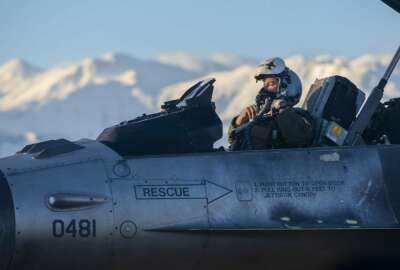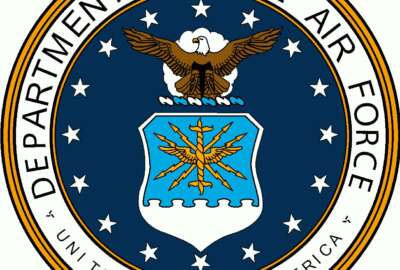
Exclusive
UPDATED: Air Force meeting with airlines on pilot shortage in May
The Air Force alone is dealing with a shortage of more than 600 pilots. The service is having trouble competing with airlines that can pay pilots more.
The Air Force is preparing to meet with commercial flight companies in hopes it can find a way to stop the bleeding of experienced pilots leaving the force.
“Our senior leaders are going to start collaborating with the airlines in May to see if we can get a public private partnership and what that might look like, so I think that’s where you’ll see we are going,” Lt. Gen. Gina Grosso, the Air Force deputy chief of staff for Manpower, Personnel and Services, told Federal News Radio.
During a March 29 House Armed Services Personnel Subcommittee hearing, Grosso said that the Air Force is exploring an intermission program that would allow pilots to fly certain seasons with an airline company and then come back to the Air Force.
The program would give pilots seniority in the commercial airline world, while still filling much needed pilot spots in the military service.
“We are also starting to look at [allowing] aviators to fly part time on their on their own. I think those are just two ideas, and there are many more,” Grosso said.
Grosso said the partnership would look for a “win-win” situation for both the airlines and the Air Force.
“How can we get stability for defending and protecting the United States and how can [the airlines] get stability in having a pipeline for their aviators? We think there are some possibilities there, especially when we look to our allies,” Grosso said. “Our allies have national airlines, so it makes it a little easier, but there are definitely some models out there that we are hoping that we can take advantage of.”
The Air Force alone is dealing with a shortage of more than 600 pilots. The service is having trouble competing with airlines that can pay pilots more. The trouble comes when pilots are up for reenlistment.
Military pilots have training and hours required to qualify to fly for the major airlines without having to work for smaller regional airlines first.
“Because major airlines work on a seniority system, the best opportunity for salary growth in the major airlines occurs for military pilots leaving after their initial service obligation,” a July 2016 RAND report stated. Another factor that is appealing to military pilots is the Federal Aviation Administration increased the mandatory retirement age for pilots from 60 to 65 in 2007, giving pilots longer to cash in on their talents.
The military services tried using reenlistment bonuses to keep pilots in the force, but their appeal is dropping.
The Navy saw a 3.7 percent drop in new retention bonus contracts in 2015, dropping from almost 59 percent to 55 percent, stated a 2016 report to Congress.
The Air Force is seeing even bigger declines. In 2013, 68 percent of eligible pilots signed on for incentive pay contracts with the Air Force. That number dropped to 59 percent in 2014 and further to 55 percent in 2015. Only 410 out of 745 pilots eligible for bonuses actually took them in 2015. Only 42 percent of pilots offered early bonus contracts took the bait.
That’s especially troubling when the Air Force estimates that the cost to train one F-22 fighter pilot, for example, is $12.5 million.
One reason the report states for the pilots’ lack of interest in bonuses is the size of the incentive pay. Pilots are allowed a maximum $25,000 bonus per year, a number that has not changed since 1999.
That incentive pay may have worked five or 10 years ago when commercial airlines weren’t paying as well, but the RAND study states commercial airline pay has rebounded to mid-1990s peak salaries of $200,000.
“We have no trouble recruiting pilots. We have more people who want to be pilots than we have spaces to train them. For us the issue is … we are not retaining enough,” Grosso said.
Grosso added that as pilots reach their 11th year in the service the Air Force needs to keep around 65 percent. Over the years, that number has slowly declined.
“We have gaps in the force and we are very, very concerned about this and our chief has called this a crisis,” Grosso said.
Grosso told Congress the new blended retirement system may provide less of an incentive for pilots to stay in the service for a full 20 years as well.
Part of the Air Force’s attempt to become more appealing to pilots involves bettering their quality of life.
“What we found in the past — and we’ve been through this before because airlines have hired before — is quality of service is as important as quality of life. And quality of service is making sure that you’re given the opportunity to be the best you can be in your design, in your chosen occupation. Pilots who don’t fly, maintainers who’s don’t maintain, controllers who don’t control, will walk. And there’s not enough money in the Treasury to keep them in if we don’t need to give them the resources to be the best they can be. In my mind, readiness and morale are inexplicably linked. Where we have high readiness, we tend to have high moral because they’re given the opportunities to compete. Where we have low readiness, we have our lowest morale,” Air Force Chief of Staff David Goldfein told the Senate Armed Services Committee last September.
To make up for that the Air Force reduced additional training and extra duties for airmen, so they can have more free time. The service is currently looking for additional areas to cut in order to better quality of life.
Rep. Martha McSally (R-Ariz.) suggested the military services try to contact pilots who left the service, but did not join an airline to see if they may be interested in flying again.
“Maybe they went to start a business of their own or tried some other ‘grass is always greener’ thing and now they are realizing they miss the camaraderie, they miss the mission … it’s challenging to try and find these people it’s challenging to find the experienced pilots that have left. Maybe they are two, three, five years out, it doesn’t matter. Retraining them with the experience they’ve had and bringing them back even for just one assignment is worth the investment,” McSally said.
Copyright © 2024 Federal News Network. All rights reserved. This website is not intended for users located within the European Economic Area.
Scott Maucione is a defense reporter for Federal News Network and reports on human capital, workforce and the Defense Department at-large.
Follow @smaucioneWFED





